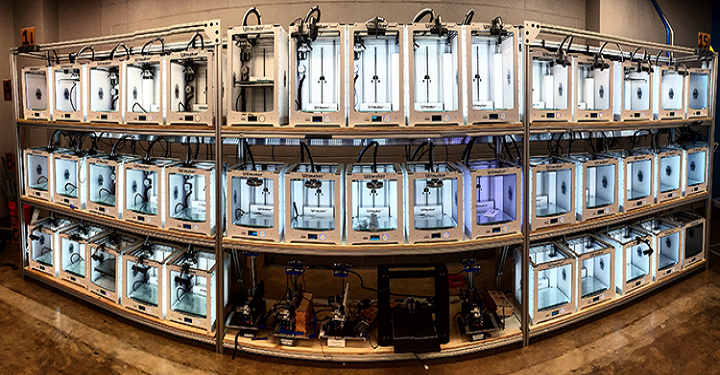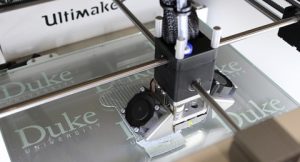Duke University’s 3D Printing Innovation Lab Allows Surgeons to Create Accurate 3D Printed Medical Training Models
Tawfig Khoury, MD, an otolaryngology (ear and throat) resident at Duke University, is focused on the latter, and uses 3D printing to improve patient care. He makes 3D printed medical models of the ear’s delicate temporal bones, which are later used for the purposes of medical training.
“One focus of my research has been taking CT scans of temporal bones, and printing an exact, patient-specific replica. Our residents can then practice drilling and performing other tests without having to work on an actual patient,” Dr. Khoury explained.
Dr. Khoury works on his 3D printed models at the university’s Innovation Co-Lab Studio, which contains a network of over 80 3D printers, ranging from MakerBot and Markforged to Ultimaker and Formlabs, that have been used for various projects since the facility began to really grow last year and explore new uses for 3D printing at the university.
“With recent renovations, we now have a state-of-the-art facility, with high-end equipment across an entire floor dedicated to the lab,” Dr. Khoury said.
“The Innovation Lab is a great example of how different departments across the hospital, as well as other healthcare groups, residents, and students, can work together to create something of value for the community.”
The lab, previously described as a “creativity incubator,” also includes 3D scanning equipment, CNC machines and laser cutters, digital modeling workstations, and a multitude of electronics.
Physicians from several of the university’s medical specialties, including cardiology, neurosurgery, and neurology, use the patient record system Epic to access an ordering system in order to have medical models 3D printed in the studio from ultrasounds and CT and MRI scans. Occasionally, the Innovation Co-Lab Studio can provide its 3D printing services at no cost if the 3D printed replica models are created specifically for patient care.
In order to receive and handle requests for 3D prints from around the world, the studio uses 3DPrinterOS, the popular online cloud management system, as a service to the university’s community. 3DPrinterOS users have access to an online, live-streaming video of the project while it’s being 3D printed.Since the facility’s expansion, a wider community of users have been taking advantage of its services. The expansion also gives Dr. Khoury the opportunity to, according to a post by Scott Behm with Duke’s Department of Surgery, “set his sights on some short- and long-term goals.”
Dr. Khoury feels that 3D printing, even though it can already create accurate models for the purposes of medical training, can go even further at the university. Before his residency at Duke is complete, he hopes to set up an efficient system in order to assist patients with facial trauma who must have maxillofacial reconstruction surgery. His main goal in this is to enable the routine creation of 3D printed models for eventual use in implants for this type of procedure.
Someday in the future, Dr. Khoury believes that we will be able to rely on 3D printers as a way to create organic replacement organs or body parts out of bioink or hydrogel, such as an eardrum, which can then be infused with live cells and implanted in a patient’s body.
Discuss this story and other 3D printing topics at 3DPrintBoard.com or share your thoughts in the Facebook comments below.
Subscribe to Our Email Newsletter
Stay up-to-date on all the latest news from the 3D printing industry and receive information and offers from third party vendors.
Print Services
Upload your 3D Models and get them printed quickly and efficiently.
You May Also Like
Inside Xometry’s 2026 Outlook: Why AM Is Becoming Essential — and What’s Still Holding It Back
In the first part of this series, we spoke with Xometry’s Senior Vice President of Marketplace Operations, Mike Cavalieri, about how manufacturers are reshoring, diversifying their suppliers, and building more...
Top 10 Moonshot Ideas for 3D Printing’s Future
As the year comes to a close, it’s clear that additive manufacturing (AM) is entering a new phase. Costs are falling, supply chains are changing, government spending is rising, and...
3D Printing News Briefs, December 31, 2025: Frenzy Engine, Adaptive Slicing, & More
It’s the last 3D Printing News Briefs of the year! On this New Year’s Eve, we’re focusing on Beehive’s completed Frenzy Engine, adaptive slicing for binder jetting, medical 3D printing...
3D Printing Predictions for 2026: Scaling AM Through Software
For several years, we have seen additive manufacturing software play a more central role in our industry. LPBF machines achieve higher yields and can produce thinner-walled parts thanks to the...
































